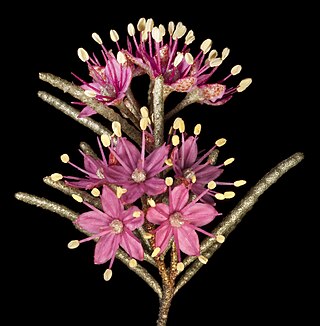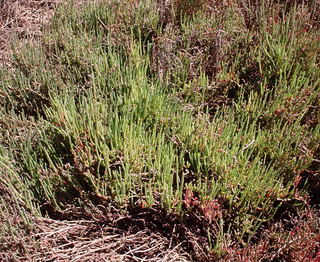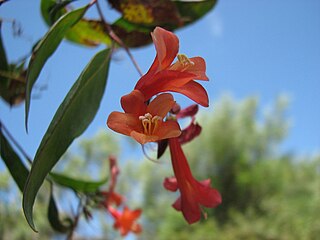
The Rutaceae is a family, commonly known as the rue or citrus family, of flowering plants, usually placed in the order Sapindales.

Murraya is a genus of flowering plants in the citrus family, Rutaceae. It is distributed in Asia, Australia, and the Pacific Islands. The center of diversity is in southern China and Southeast Asia. When broadly circumscribed, the genus has about 17 species. A narrower circumscription contains only eight species, others being placed in Bergera and Merrillia.

Commersonia is a genus of twenty-five species of flowering plants in the family Malvaceae. Plants in this genus are shrubs or trees, occurring from Indochina to Australia and have stems, leaves and flowers covered with star-like hairs. The leaves are simple, often with irregularly-toothed edges, the flowers bisexual with five sepals, five petals and five stamens and the fruit a capsule with five valves. The genus underwent a revision in 2011 and some species were separated from Commersonia, others were added from Rulingia.

Dodonaea, commonly known as hop-bushes, is a genus of about 70 species of flowering plants in the soapberry family, Sapindaceae. The genus has a cosmopolitan distribution in tropical, subtropical and warm temperate regions of Africa, the Americas, southern Asia and Australasia, but 59 species are endemic to Australia.

Chamelaucium, also known as waxflower, is a genus of shrubs endemic to south western Western Australia. They belong to the myrtle family Myrtaceae and have flowers similar to those of the tea-trees (Leptospermum). The most well-known species is the Geraldton wax, Chamelaucium uncinatum, which is cultivated widely for its large attractive flowers.

Phebalium is a genus of thirty species of shrubs or small trees in the family Rutaceae and is endemic to Australia. The leaves are arranged alternately, simple and often warty, the flowers arranged singly or in umbels on the ends of branchlets or in leaf axils, usually with five sepals, five petals and ten stamens. There are about thirty species and they are found in all Australian states but not in the Northern Territory.
Thomas Gordon Hartley was an American botanist.

Petrophile is a genus of evergreen shrubs, in the family Proteaceae. The genus is endemic to Australia. Commonly known as conebushes, they typically have prickly, divided foliage and produce prominently-displayed pink, yellow or cream flowers followed by grey, conical fruits.

Lasiopetalum, commonly known as velvet bushes, is a genus of about forty-five species of flowering plants in the family Malvaceae, all endemic to Australia.

Dictamnus is a genus of flowering plant in the family Rutaceae, native to temperate Eurasia from Spain to China. The genus was first described by Carl Linnaeus in 1753.

Tecticornia is a genus of succulent, salt tolerant plants largely endemic to Australia. Taxa in the genus are commonly referred to as samphires. In 2007, the genus Halosarcia, along with three other Australian genera was incorporated into the genus.
Rulingia is a genus of flowering plants native to Australia and Madagascar. In 2011, all species were transferred to Commersonia with the exception of Rulingia cuneata, R. loxophylla, R. luteiflora and R. procumbens which have been transferred to the new genus Androcalva.

Microcybe is a genus of plants in the family Rutaceae, all of which are native to Australia.

Microcybe multiflora is a small shrub in the family Rutaceae. The species is endemic to Australia. It usually grows to between 0.2 and 1 metre high and produces cream to yellow flowers.

Marianthus is a genus of flowering plants in the family Pittosporaceae and is endemic to Australia. Plants in the genus Marianthus are shrubs with twining branches, simple leaves arranged alternately along the stems. The flowers are pendent, arranged singly or in small groups in upper leaf axils or on the ends of branches with small bracts and bracteoles at the base, but that fall as the flowers open. The sepals are free from each other, and the petals are also sometimes free from each, otherwise joined at the base, forming a tube with spreading lobes. Plants in this genus were previously included in Billardiera, but have a stalked ovary and a long, usually curved style. The fruit is a dehiscent capsule containing many seeds.
Kelly Anne Shepherd is an Australian botanist, who has published some 91 names.

Zanthoxyloideae is a subfamily of the family Rutaceae. Its most notable member is probably Sichuan pepper.

Geleznowia verrucosa is a species of flowering plant in the family Rutaceae. It is a small shrub with oval-shaped leaves, yellow flowers and is endemic to Western Australia.

Bergera is a genus of flowering plants in the family Rutaceae. It has been included in Murraya as M. sect. Bergera. Species that may be placed in the genus are native from India through southeast Asia eastwards to China and Taiwan southwards to Malesia and New Caledonia. The curry tree, Bergera koenigii, is one of the better known species.
Macrostylis is a genus of flowering plants in the family Rutaceae. It includes 10 species endemic to the Cape Provinces of South Africa.















